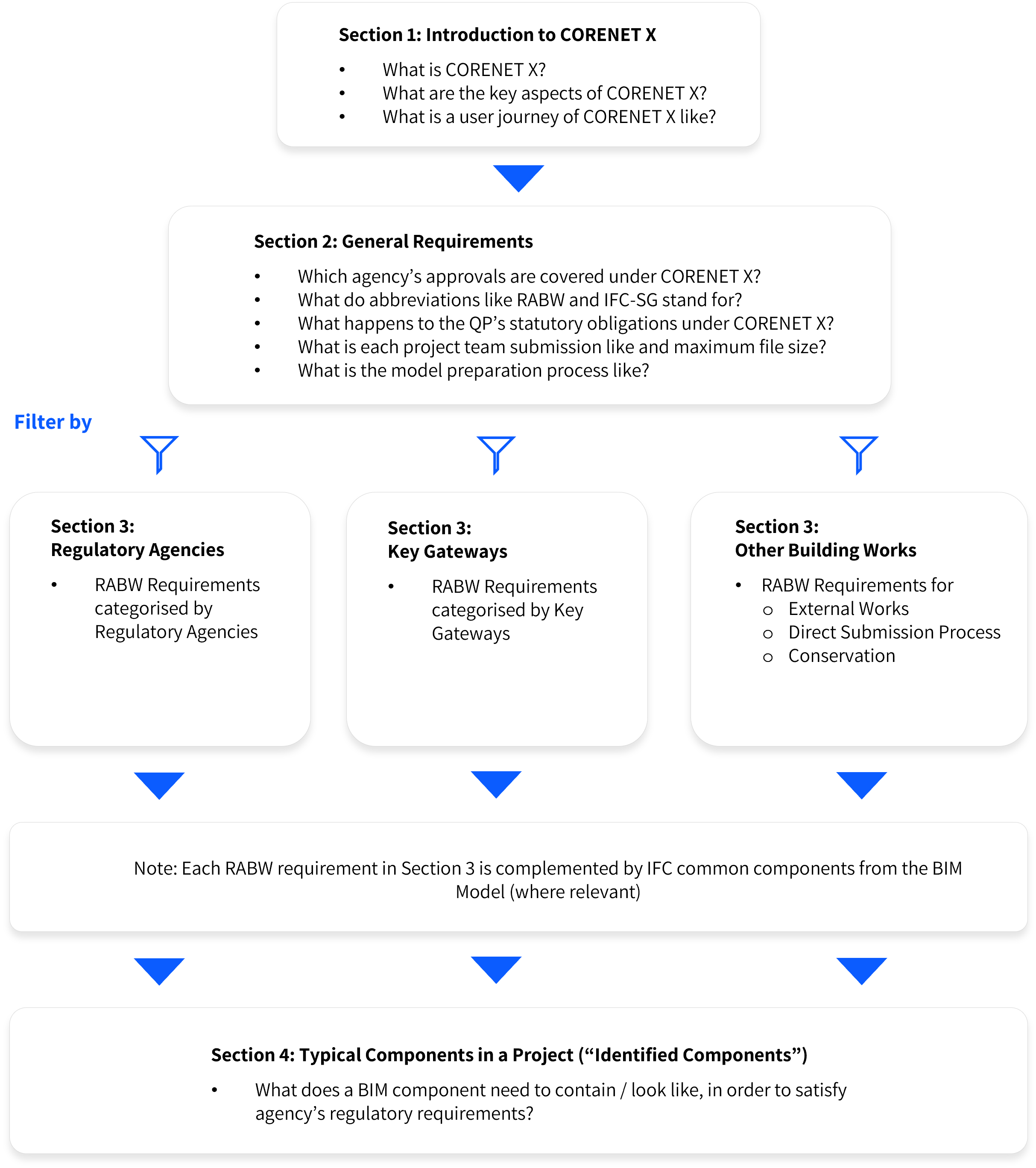Preamble
This Code of Practice (COP) is intended to help industry practitioners in understanding how to prepare multi-agency regulatory submissions across the key submission gateways in CORENET X.
This Code of Practice, where relevant, will include recommended procedures and good practices to address common Building Information Modelling (BIM) issues at general project collaboration level (e.g. multi-disciplinary project set-up, geo-referencing) and specific details that vary from firm to firm today.
This Code of Practice complements the IFC+SG Resource Kit, which provides technical templates and help resources from key proprietary BIM software for the generation of IFC+SG models.
Disclaimer
This Code of Practice details the envisaged end state of CORENET X. CORENET X is developed through Agile Methodology and hence, features and requirements mentioned in this COP will be developed progressively, and its technological enhancements will be made available in phases. For the exact implementation date, please refer to official circulars.
This Code of Practice does not substitute Handbooks, Circulars or other regulatory publications of our regulatory agencies. Readers should refer to the relevant Codes, Acts and Regulations on the compliance required for their projects, before referring to this Code of Practice on how to represent the compliance information in the CORENET X submission gateways.
Readers should consult relevant agencies if they need to determine the regulatory requirements to fulfil compliance.
How to use this Code of Practice
Note: CORENET X is developed through Agile Methodology and sections / requirements in this COP will be updated progressively and its technological enhancements will be made available in phases.

Code of Practice (Updated)
| CORENET X Code of Practice 3.1 Edition CORENET X COP 3.1 Edition 2025-12 |
Annex |
Feedback on CORENET X Code of Practice
We welcome your feedback and queries about the Code of Practice so that we can continue to develop and improve it. You may submit your comments or suggestions via our dedicated feedback channel at https://go.gov.sg/cxenquiry.
Archive
| CORENET X Code of Practice Third Edition CORENET X COP 3 Edition 2025-09 |
Annex |
| CORENET X Code of Practice 2.1 Edition CORENET X COP 2.1 Edition 2024-11 |
| CORENET X Code of Practice Second Edition CORENET X COP Second Edition 2024-11 |
Annex (Second Edition) |
| CORENET X Code of Practice First Edition CORENET X COP First Edition 2023-09 |
Annex (First Edition) |
Terms and Definitions
For the purpose of this Code of Practice, the following definitions shall apply:
| Term | Definitions | |
|---|---|---|
| RABW | Abbreviation for “Regulatory Approval Process for Building Works”, and refers to the new process involving 3 key sequential submission gateways to all Agencies for one collective and coordinated approval at each gateway. | |
| Gateways | Major submission milestones in CORENET X, where the submission needs to comply with multiple agencies’ statutory requirements at each Gateway.
•Multiple Agency requirements listed under each regulatory agency can be found here. •Multiple Key Gateway requirements listed under each gateway can be found here. | |
| Supporting Mechanisms | Similar to today, there are 3 supporting mechanisms will continue to complement the approval process: 1. Pre-Submission Consultation •Pre-submission consultation will continue to be available for industry to consult or seek clarification prior to submission. 2. Waivers •Where necessary, the industry may apply for waiver under the respective Act and Regulations and the respective agency will assess the applications accordingly. 3. Escalation Mechanism •Industry can table their case to seek resolution on inter-agency regulatory conflicts at the Inter-agency Coordinating Committee (IACC). | |
| Federated Model | Combined Building Information Model that compiles multiple models from different disciplines or sections of the project into a single, complete model of the project.
•Federated models support concurrent authorship of different aspects of the project by multiple parties. •Federated models also support multi-disciplinary coordination as models are geo-referenced to coordinates from the Singapore SVY21 coordinate system (EPSG: 3414) for Easing and Northing (x,y) and Singapore Height Datum (SHD) for Height (z). | |
| IFC+SG | New representations for local regulatory requirements, in the Industry Foundation Classes (IFC) openBIM standard. More information of the mapping and configuration files for IFC+SG can be found here. | |
| Level of Details | As long as relevant IFC+SG data requirements are embedded in the respective BIM components and minimum dimensions represented, BIM components do not need to replicate their real-life equivalent.  | |
| Non-BIM submissions | Besides BIM submissions in the IFC+SG format, CORENET X will be able to accept non-BIM submissions. | |
| Supplementary Documents | CORENET X will be able to accept non-BIM documentations that accompany each project team’s submission of IFC+SG models (e.g. design calculation reports, 2D supplementary drawings) | |